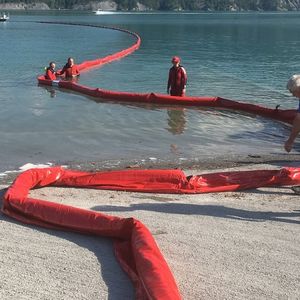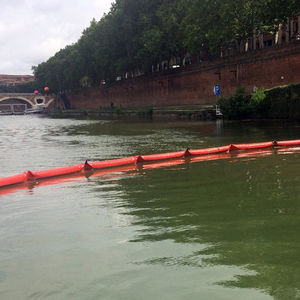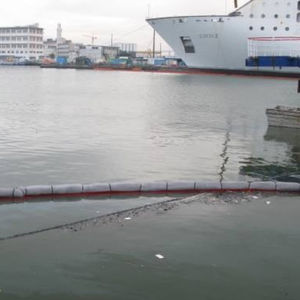
- Products
- Catalogs
- News & Trends
- Exhibitions
Pollution control boom BARC 1545Rfloatingfoamriver


Add to favorites
Compare this product
Characteristics
- Type
- pollution control
- Technology
- floating, foam
- Application zone
- river, for harbor, intertidal
- Other characteristics
- modular
Description
This BARC 1545R floating boom is made up of a succession of flexible tubes of closed cell foam inserted in waterproof envelopes in polyester fabric coated with hydrocarbon treated PVC (900g / m2).
It is reinforced with a galvanized nautical steel ballast chain in a sheath over its entire length.
The compartmentalization of the elements allows this containment dam to follow the movements on the surface of the water. Its great flexibility gives it excellent behavior in the face of strong winds and currents.
Each floating boom is equipped at both ends with plates with bolts to connect them together and with two handles to facilitate their implementation.
Containment dam with high resistance:
- tearing and twisting
- at a temperature ranging from - 30 ° C to + 70 ° C.
- to wear and abrasion.
- hydrocarbons, fatty substances and almost all industrial chemicals and agents.
- to ultraviolet rays.
This pollution barrier is washable with water and has stainless steel bolts.
Long: 15 m
Total height: 45 cm
Air draft: 15 cm
Draft: 30 cm
Weight: 48 kg.
Stored volume: 0.55 m3
Red color.
Fixing & traction system in addition (ref. BARC ANC1)
Use as a preventive or curative in the event of pollution on the water by:
- estuary
- coastal waters
- refinery,
- Harbor zone,
- rejection channel,
- barge, barge or tanker,
- wastewater treatment plant,
- river and lake.
We design and manufacture anti-pollution booms to confine, absorb, filter hydrocarbons, suspended matter, turbidity, plants, floating objects ...
Contact us for advice or a quote.
Related Searches
- Floating boom
- Containment boom
- Sheltered waters boom
- River boom
- Hydrocarbon absorber
- Harbor boom
- Harbors and terminal absorber
- Permanent boom
- Oil absorber
- Aquatic environment absorber
- Modular boom
- Foam boom
- Safety boom
- Oil spill pad absorber
- Demarcation boom
- Roll absorber
- Debris boom
- Fuel absorber
- Fuel absorber
- High seas boom
*Prices are pre-tax. They exclude delivery charges and customs duties and do not include additional charges for installation or activation options. Prices are indicative only and may vary by country, with changes to the cost of raw materials and exchange rates.
















